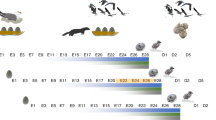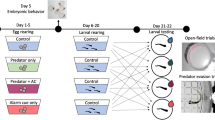Abstract
Predation risk influences the duration of offspring development in many species where embryos develop from externally shed eggs. Surprisingly, such predator-mediated effects on offspring development have rarely been explored in live-bearers. In this paper, we use the guppy (Poecilia reticulata), a live-bearing freshwater fish, to test whether the duration of brood retention (the time from mating to parturition) is influenced by experimental changes in the perceived level of predation. Because the swimming performance of female guppies is impaired during late pregnancy, we predicted that females would withhold broods for shorter periods when they are exposed to cues that signal a heightened risk of predation on adults rather than on juveniles. We therefore simulated increased risk of predation on adults by using a combination of pike-shaped models (resembling natural predators that prey on adult guppies) and ‘alarm substances’ derived from the skin extracts of adult conspecific females. Our results revealed that, under simulated predation risk, female guppies produced broods significantly more quickly than their counterparts assigned to a control group where predator cues were absent. A subsequent evaluation of offspring swimming performance revealed a significant positive association between neonate swimming speeds and the duration of brood retention, suggesting that by accelerating parturition, females may produce offspring with impaired locomotor skills. These findings, in conjunction with similar results from other live-bearing species, suggest that the conditions experienced by gestating females can generate significant variation in the timing of offspring development with potentially important implications for offspring fitness.



Similar content being viewed by others
References
Brown GE (2003) Learning about danger: chemical alarm cues and local risk assessment in prey fishes. Fish Fish 4:227–234
Brown GE, Poirier J-F, Adrian JC (2004) Assessment of local predation risk: the role of subthreshold concentrations of chemical alarm cues. Behav Ecol 15:810–815
Dzikowski R, Hulata G, Harpaz S, Karplus I (2004) Inducible reproductive plasticity of the guppy Poecilia reticulata in response to predation cues. J Exp Zool 301A:776–782
Endler JA (1995) Multiple-trait coevolution and environmental gradients in guppies. Trends Ecol Evol 10:22–29
Evans JP, Magurran AE (2000) Multiple benefits of multiple mating in guppies. Proc Natl Acad Sci US Am 97:10074–10076
Evans JP, Kelley JL, Ramnarine IW, Pilastro A (2002) Female behaviour mediates male courtship under predation risk in the guppy. Behav Ecol Sociobiol 52:496–502
Evans JP, Kelley JL, Bisazza A, Finazzo E, Pilastro A (2004) Sire attractiveness influences offspring performance in guppies. Proc R Soc Lond B Biol Sci 271:2035–2042
Ghalambor CK, Reznick DN, Walker JA (2004) Constraints on adaptive evolution: the functional trade-off between reproduction and fast-start swimming performance in the Trinidadian guppy (Poecilia reticulata). Am Nat 164:38–50
Houde AE (1997) Sex, color, and mate choice in guppies. Princeton University Press, Princeton NJ
Johansson J, Turesson H, Persson A (2004) Active selection for large guppies, Poecilia retiwlata, by the pike cichlid, Crenicichla saxatilis. Oikos 105:595–605
Krause J, Ruxton GD (2002) Living in groups. Oxford University Press, Oxford
Kusch RC, Chivers DP (2004) The effects of crayfish predation on phenotypic and life-history variation in fathead minnows. Can J Zool 82:917–921
Li DQ (2002) Hatching responses of subsocial spitting spiders to predation risk. Proc R Soc Lond B Biol Sci 269:2155–2161
Lima SL (1998) Stress and decision making under the risk of predation: recent developments from behavioral, reproductive, and ecological perspectives. Adv Study Anim Behav 27:215–290
Lima SL, Dill LM (1990) Behavioral decisions made under the risk of predation: a review and prospectus. Can J Zool 68:619–640
Magurran AE (1990) The adaptive significance of schooling as an anti-predator defence in fish. Ann Zool Fenn 27:51–66
Magurran AE (2005) Evolutionary Ecology: the Trinidadian guppy. Oxford University Press, Oxford
Magurran AE, Girling SL (1986) Predator model recognition and response habituation in shoaling minnows. Anim Behav 34:510–518
Magurran AE, Seghers BH (1994) Sexual conflict as a consequence of ecology: evidence from guppy, Poecilia reticulata, populations in Trinidad. Proc R Soc Lond B Biol Sci 255:31–36
Magurran AE, Phillip DAT (2001) Evolutionary implications of large-scale patterns in the ecology of Trinidadian guppies, Poecilia reticulata. Biol J Linn Soc 73:1–9
Matthews IM, Magurran AE (2000) Evidence for sperm transfer during sneaky mating in wild Trinidadian guppies. J Fish Biol 56:1381–1386
Mattingly HT, Butler MJ (1994) Laboratory predation on the Trinidadian guppy: implications for the size-selective predation hypothesis and guppy life history evolution. Oikos 69:54–64
Mirza RS, Chivers DP (2002) Behavioural responses to conspecific disturbance chemicals enhance survival of juvenile brook charr, Salvelinus fontinalis, during encounters with predators. Behaviour 139:1099–1109
Nordell SE (1998) The response of female guppies, Poecilia reticulata, to chemical stimuli from injured conspecifics. Environ Biol Fishes 51:331–338
Pitcher TJ, Parrish JK (1993) Functions of shoaling behaviour in teleosts. In: Pitcher TJ (ed) Behaviour of teleost fishes. Chapman & Hall, London, pp 363–439
Plaut I (2002) Does pregnancy affect swimming performance of female mosquitofish, Gambusia affinis? Funct Ecol 16:290–295
Pocklington R, Dill LM (1995) Predation on female or males: who pays for bright male traits? Anim Behav 49:1122–1124
Reznick DN, Endler JA (1982) The impact of predation on life history evolution in Trinidadian guppies (Poecilia reticulata). Evolution 36:125–148
Reznick DN, Bryga H, Endler JA (1990) Experimentally induced life-history evolution in a natural population. Nature 346:357–359
Reznick DN, Shaw FH, Rodd FH, Shaw RG (1997) Evaluation of the rate of evolution in natural populations of guppies (Poecilia reticulata). Science 275:1934–1937
Richter SC (2000) Larval caddisfly predation on the eggs and embryos of Rana capito and Rana sphenocephala. J Herpetol 34:590–593
Saenz D, Johnson JB, Adams CK, Dayton GH (2003) Accelerated hatching of southern leopard frog (Rana sphenocephala) eggs in response to the presence of a crayfish (Procambarus nigrocinctus) predator. Copeia 646–649
Seghers BH (1974) Geographic variation in the responses of guppies (Poecilia reticulata) to aerial predators. Oecologia 14:93–98
Shaffer LR, Formanowicz DR (1996) A cost of viviparity and parental care in scorpions: reduced sprint speed and behavioural compensation. Anim Behav 51:1017–1023
Shine R (2003) Effects of pregnancy on locomotor performance: an experimental study on lizards. Oecologia 136:450–456
Shine R, Downes SJ (1999) Can pregnant lizards adjust their offspring phenotypes to environmental conditions? Oecologia 119:1–8
Shine R, Olsson M (2003) When to be born? Prolonged pregnancy or incubation enhances locomotor performance in neonatal lizard (Scincidae). J Evol Biol 16:823–832
Sih A, Moore RD (1993) Delayed hatching of salamander eggs in response to enhanced larval predation risk. Am Nat 142:947–960
Sinervo B, Hedges R, Adolph SC (1991) Decreased sprint speed as a cost of reproduction in the lizard Sceloporus occidentalis—variation among populations. J Exp Biol 155:323–336
Templeton CN, Shriner WM (2004) Multiple selection pressures influence Trinidadian guppy (Poecilia reticulata) antipredator behavior. Behav Ecol 15:673–678
Wapstra E (2000) Maternal basking opportunity affects juvenile phenotype in a viviparous lizard. Funct Ecol 14:345–352
Warkentin KM (1995) Adaptive plasticity in hatching age—a response to predation risk trade-offs. Proc Natl Acad Sci US Am 92:3507–3510
Webb JK (2004) Pregnancy decreases swimming performance of female northern death adders (Acanthophis praelongus). Copeia 357–363
Wedekind C, Muller R (2005) Risk-induced early hatching in salmonids. Ecology 86:2525–2529
Wisenden BD, Chivers DP, Smith RJF (1995) Early warning in the predation sequence—a disturbance pheromone in Iowa darters (Etheostoma exile). J Chem Ecol 21:1469–1480
Acknowledgement
We thank Ferdinando Benatelli for the help with the experiments and Jennifer Kelley and two anonymous referees for comments on a previous draft of the manuscript. This work was supported by grants from the Italian Research Ministry (AP) and the Australian Research Council (JPE). The research conformed to the relevant Italian laws governing the care of animals in research (D.L. 116/27-01-92, C.M.S. 8/22-04-94) and was authorized by the Istituto Superiore di Sanità (National Health Institute).
Author information
Authors and Affiliations
Corresponding author
Additional information
Communicated by J. Krause
Rights and permissions
About this article
Cite this article
Evans, J.P., Gasparini, C. & Pilastro, A. Female guppies shorten brood retention in response to predator cues. Behav Ecol Sociobiol 61, 719–727 (2007). https://doi.org/10.1007/s00265-006-0302-1
Received:
Revised:
Accepted:
Published:
Issue Date:
DOI: https://doi.org/10.1007/s00265-006-0302-1




